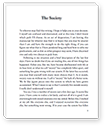Essay Instructions: I need a three page essay on the following info.
Expository essays attempt to educate an audience about a topic and, ultimately, explain ideas they may not have understood before reading your essay. You can use the expository style for multiple purposes such as informing, persuading, and explaining. In our course, we will focus on the informative style of expository writing. To be convincing, essays must be justified by evidence and be logically sound.
You should document all sources using APA citation.
Introduction
A. Crack cocaine is one of the most addictive and destructive illicit recreational drugs ever introduced into American society.
B. The crack cocaine epidemic that resulted from its introduction to society was one of the most destructive things to occur to many urban societies. Until it was properly and successfully addressed by law enforcement efforts throughout the 1990s, it was responsible for more addiction and more drug-trade-related deaths than any other illicit drug in American history.
C. Crack cocaine is a popular drug that leads to crime; however, there are solutions to the problem.
II. What crack is and why it is so popular
A. Crack is another name for free-base cocaine. It was invented in the early 1980s by innovative street drug dealers who recognized that smokable freebase cocaine would be tremendously profitable, precisely because it allowed the sale of minute quantities of a drug that normally required large quantities of powdered cocaine to produce. Smoking freebase cocaine is the most addictive form of ingesting cocaine, already a profoundly addictive drug for many users (Baumer, 2007).
B. Freebase refers to the chemical process of changing the chemical structure of the cocaine molecule by one of several methods such as by using ether solvents or baking soda solutions (Baumer, 2007).
C. Until the invention of pre-prepared small quantities of “crack” cocaine, freebase cocaine was only available to relatively wealthy individuals because the chemical process requires much more cocaine that poor drug users can afford to procure at any one time (Baumer, 2007; Schmalleger, 2008).
III. How does crack lead to crime? What crimes?
A. Crack cocaine was the direct cause of the most dramatic increase in violent crime in many American cities in the modern era of law enforcement (Schmalleger, 2008).
B. During the 1990s, the turf wars that erupted on the streets on many New York City neighborhoods (for just one example) were the direct result of the incredible profitability of crack cocaine and the competition among dealers for business (Safir, 2003).
In Washington Heights, a largely Hispanic community in Northern Manhattan, crack cocaine-related violence among street dealers led to the highest murder rate that New York City had ever recorded (Safir, 2003).
IV. What are solutions to the crack and crime problems?
A. Until law enforcement succeeded in redressing the problem through proactive enforcement and prosecution, crack cocaine was responsible for the most violent era of drug-related crime in modern American law enforcement history. The problem of crack cocaine has not been addressed very effectively. Although there was great concern about the drug in the mid-80's through the 1990s, crack use and all its negative consequences are now part of our country's socio-cultural landscape. It is not a pretty picture.
We need to do a better job of reaching out to and treating crack cocaine users. We also need to rethink our prevention efforts since they are generally geared to young people and crack cocaine use is most often initiated after people leave high school. (Local Study on Crack Cocaine Have National Implications, 2007, September 5).
B.Substance use is a major public health problem: it affects the health of a vast number
of Americans and results in tremendous costs to US society overall. The public health
community must provide strong and decisive leadership in informing policy,
advocating for needed research funds, and bringing practice in line with scientific
advances in substance abuse prevention and treatment, The current treatment gap
unduly affects children, who through the failure of US society to address their
parents' addictions, are at profound risk of becoming the next generation in
need of treatment. (Amaro, 1999)
V. Conclusion
A. Crack cocaine is a popular drug that leads to crime; however, there are solutions to the problem.
B. Crack tears apart individuals as well as communities; the drug can lead to permanent deleterious effects on the body and mind and even affect future generations.
C. Crack is a highly processed form of cocaine hydrochloride that has been around since the 1980s. Unlike powdered cocaine, crack is cheap and is usually smoked. Crack wreaks havoc on individuals and whole communities.
References
American Council for Drug Education (2001). Basic facts about drugs: cocaine. Retrieved Nov 17, 2009 from http://www.acde.org/common/Cocaine.htm
Baumer, E. (2007). Poverty, crack, and crime: A cross-city analysis. Journal of Research in Crime and Delinquency, Vol. 31, No. 3, 311-327
Cowen, T. (2005). Crime and crack. Out of the Crooked Timber. Retrieved Nov 17, 2009 from http://crookedtimber.org/2005/05/23/looking-forward/
Crack Addicts Face Added Stigma in Housing (2007). Join Together. Retrieved Nov 17, 2009 from http://www.jointogether.org/news/headlines/inthenews/2007/crack-addicts-face-added.html
Dershowitz, A. (2002). Shouting Fire: Civil Liberties in a Turbulent Age. New York: Bantam Books.
“In Search of the Big Bang.” (nd). Retrieved Nov 17, 2009 from http://www.cocaine.org/
National Institute on Drug Abuse (2009). Crack and cocaine. Retrieved Nov 17, 2009 from http://www.nida.nih.gov/Infofacts/cocaine.html
Safir, H. (2003). Security: An Inside Look at the Tactics of the NYPD. New York: St. Martin’s Press.
Schmalleger, F. (2008). Criminal Justice Today: An Introductory Text for the 21st Century. Hoboken, NJ: Prentice Hall.
(2007, September 5). Results of Local Study on Crack Cocaine Have National Implications. Ascribe Newswire: Health, p. 1. Retrieved from Health Source - Consumer Edition database.
Amaro, H. (1999, May). An Expensive Policy: The Impact of Inadequate Funding for Substance Abuse Treatment. American Journal of Public Health, pp. 657-659. Retrieved from Professional Development Collection database.


